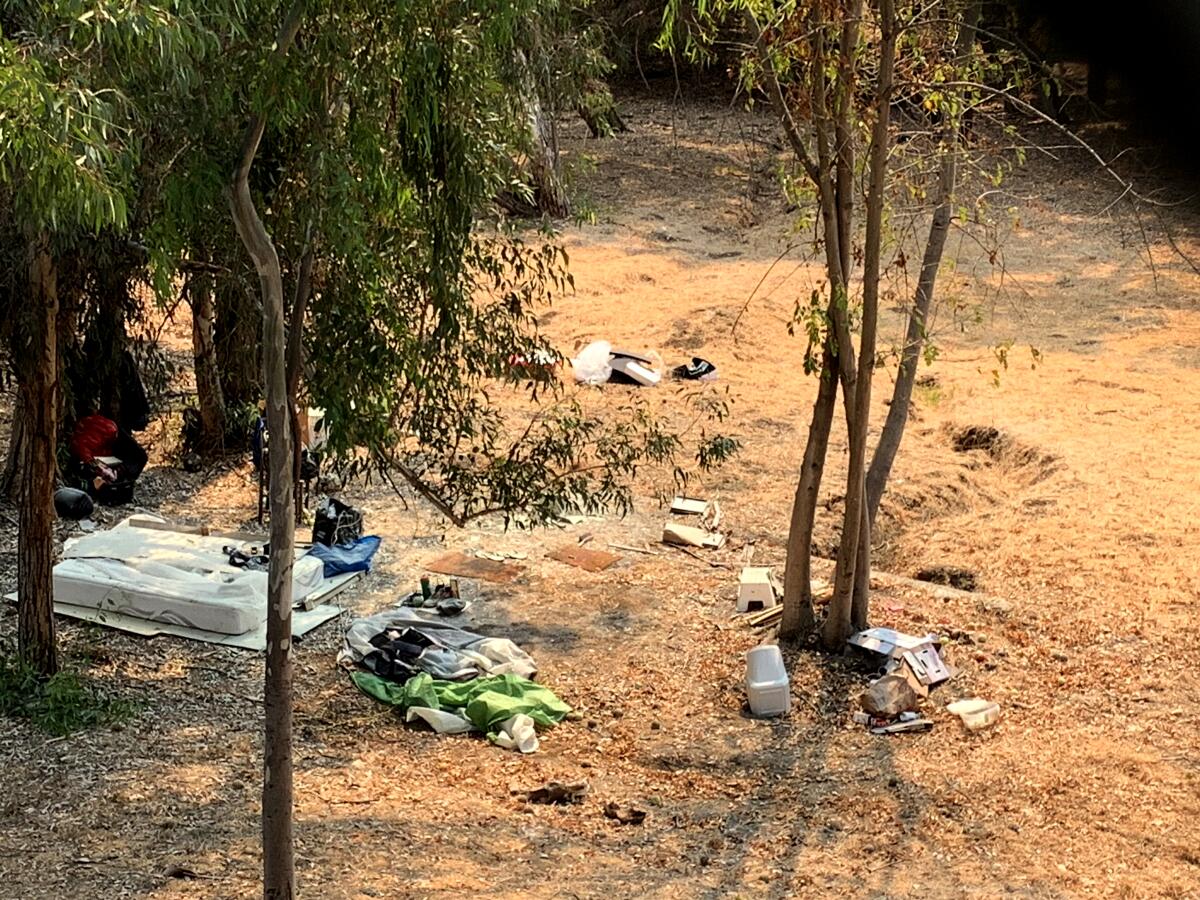Fire-prone brush is no place for homeless people to camp

- Share via
Homeless encampments are grim fixtures in Los Angeles. There isn’t enough housing and shelter for a homeless population that has increased by 16% in the city over the last year. And with a pandemic still raging, city officials have let encampments stay put (for the most part) lest homeless people contract or spread COVID-19 by being shooed from one location to another.
But another grim reality in Los Angeles is fire. And that is the one reason — notwithstanding the above concerns — to move homeless people out of encampments in brush areas and wooded parks. There has been an astonishing 80% uptick in fires involving homeless people so far this year, over the same time period in 2019.
Fires are so pervasive and intense that city fire officials believe homeless encampments in areas considered to be most at risk for fire are now a threat to public safety year-round. Not only might homeless people end up trapped in a brush fire, but any cooking they do — on portable stoves, grills and hot plates — could accidentally start one.
The Skirball fire that destroyed six homes in the Bel-Air neighborhood, damaged dozens of others and burned more than 400 acres in December 2017 was sparked by a cooking fire at an encampment in a canyon off Sepulveda Boulevard. Over the last several years, numerous smaller fires in the grassy parkland of the Sepulveda Basin and Hansen Dam in the San Fernando Valley have been attributed to homeless people, according to L.A. Fire Department officials.
On a recent hot night, homeless campers in a wooded area of the West L.A. campus of the U.S. Department of Veterans Affairs started up a cooking fire in a tin coffee can. Nearby residents spotted the flames and called the Fire Department. The campers put it out minutes before firefighters and VA police arrived, and then fled, leaving behind a mattress and clothing. That same weekend, officials say, a homeless person set off a small brush fire in the Sepulveda Basin. The body of another homeless person was discovered at the site.
To be sure, there are far more homeless-related fires in skid row and densely populated parts of the city than there are in the brush and wooded areas. From January to August of this year, there were 3,616, according to the Fire Department. Most were small and quickly extinguished — a fire in a trash can, a tent catching fire from a hot plate.
While all those fires are dangerous, few would explode into a wildfire the way a campfire in the brush could.
Adding to the complications, it’s extraordinarily difficult to reach out to homeless people in brush encampments. Outreach workers can spend hours hiking to a secluded campsite to which firefighters or neighbors have alerted them, only to find that homeless people have moved on — or cannot be persuaded to leave. Homeless people shrouded in the brush are hardy and self-reliant and not looking for handouts of food or shelter beds. So outreach workers are reduced to offering warnings and flyers. Los Angeles Homeless Services Authority outreach workers never clear encampments (nor should they) and never confiscate any items, including cooking stoves.
Even clearing camps is difficult. Law enforcement and sanitation workers can only evacuate people on city-owned property. (For other properties, they must contact the owners.) It’s true that officials may order evacuations at any time in areas of high fire risk. However, it’s a labor-intensive undertaking, requiring multiple trips by police, sanitation workers and outreach workers, so it’s generally done on days when the fire risk is highest.
But flyers and warnings aren’t enough. The city shouldn’t wait for the days when the fire risk is greatest. We realize it’s an arduous task for police and sanitation workers when their resources are already limited, but consider the consequences of inaction: a horrific fire that could take out a neighborhood. If no housing or shelter is available for displaced campers — or people refuse what is available — the city should consider offering vouchers for several days in a motel or setting up sanctioned campgrounds.
The VA is doing that for homeless veterans. Although the VA doesn’t allow encampments in the wooded parts of its campus (where the recent campfire was discovered), it has set up a tent city on an open, grassy expanse of the campus. Veterans are offered bathroom facilities, meals, mental health and medical care, and outreach services to help get them housing. But it’s only a stopgap measure. The VA has been working for years on a plan to build housing for homeless veterans.
The fact that the choices are so bleak for homeless people is another reminder that housing and shelter are desperately needed. But camping in an area at risk for fire should not be a choice at all.
More to Read
A cure for the common opinion
Get thought-provoking perspectives with our weekly newsletter.
You may occasionally receive promotional content from the Los Angeles Times.






